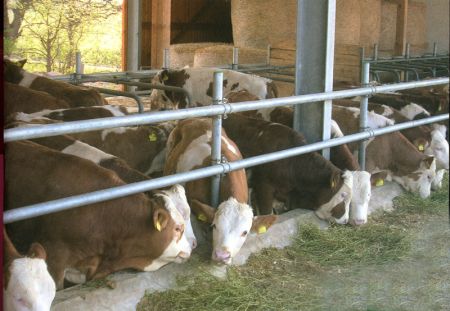According to Statistics Austria, the average finishing weight of bulls was 665 kg in 1995 and 689 kg in 2009. According to the Austrian federal report on cattle fattening, the average final fattening weight was 688 kg in 2005 and 703 kg in 2009.
At first glance, higher fattening weights also represent higher profits for bull fatteners. In Austria, the monetary value of the cattle carcass is made up of its weight and the classification according to the commercial class (EUROP) and fat class (1-5). The commercial class classification is based on the quantity of meat and not the quality of the meat.
According to Wiedner et al. (2008), the proportion of bull carcasses that are too fat is increasing in Austria, which can be attributed to these increasing final fattening masses. Particularly in the last stage of fattening, more fat is stored, with storage fat and intermuscular fat being formed first and the intramuscular fat necessary for good meat quality only relatively late. A low intramuscular fat content is particularly evident in pure-bred Simmental cattle, the main cattle breed in Austria, which is probably related to breeding for milk. The size of the cuts and the sometimes severe fattening of the cuts pose a problem for sale in the trade.
The protein supply of fattening bulls is currently a controversial topic, especially since the new energy and protein requirements standards from the GfE are not yet available. Experiments by Steinwidder et al. (2006) indicate that in finishing fattening the protein supply via protein concentrates (soy extraction meal) can be significantly reduced.
In the present experiment, 20 Simmental bulls each will be fattened in two rounds with a typical Austrian bull fattening ration consisting of maize silage ad libitum and concentrated feed at the LFZ Raumberg-Gumpenstein. The bulls are divided into 2 groups, one group being fattened up to 690 kg and the other up to 760 kg live weight. From 500 kg live weight, each group is divided again so that 5 animals per weight group receive a normal amount of concentrated protein feed and the other five animals each receive a reduced amount of protein.
Project goals
- Showing the advantages and limitations of fattening bulls to high final fattening weights (> 700 kg).
- Determination of daily weight gain, feed intake and feed conversion efficiency in the weight range 700 to 760 kg
- Investigation of two protein supply levels (usual and reduced) in finishing (from 500 kg live weight) and comparison with the new energy and protein requirement standards of the GfE
- Demonstrating differences in slaughter performance (culling, proportion of valuable cuts, meat, fat class, etc.) and meat quality (back muscle size, intramuscular fat content, meat tenderness, water-binding capacity, fatty acid pattern, etc.) of fattening bulls with a live weight of up to 690 or 760 kg
- Use of intraruminal rumen sensors for continuous measurement of the pH value and temperature in the rumen
- Economic evaluation of bull fattening for high final fattening weights
Further information on project management can be found in the database for research and sustainable development (Dafne) -> Link







